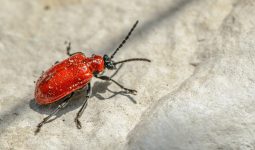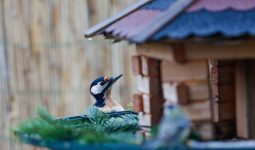Imagine relaxing at night when a swarm of bats suddenly flies out of your attic.
It’s terrifying; after that, all you can think about is keeping bats out of your house.
A combination approach has been shown to be the most effective for keeping bats away from a house.
A significant factor is using an exclusion method. On the other hand, you should try to eliminate all food sources.
It is also good to add deterrents and introduce smells that bats detest, such as peppermint or clove.
There are other possibilities; you may even need to see a professional.
Here’s a guide on how to keep bats out of your house.
Bats and Disease
Bats significantly threaten disease transmission because of their mobility and social behavior.
Although just around 6 percent of bats are infected, they are the leading cause of rabies in people. Once the illness shows signs, it is virtually invariably deadly.
Amazingly, bats are responsible for 70% of human rabies deaths, as reported by the CDC. With their sharp teeth, bats may easily bite someone as they sleep and leave no visible marks.
If you wake up to bats in your room, you should be checked out by a doctor and get the necessary immunizations.
If a bat behaves abnormally, such as sleeping low to the ground or on your grass or home’s flooring, it is highly likely to be afflicted with rabies.
In this case, you should take all precautions and figure out how to keep bats out of your house.
Whether hiring a professional pest control service or using the DIY methods and safety precautions discussed below.
Tips on How to Keep Bats Out of Your House
Install Yellow Porch Lights
Generally, bats will avoid areas where lights are very bright. If you use regular light bulbs in your house, insects and other pests may be drawn to them.
That will attract bats, which may be problematic since they need food to survive. Still, bright yellow lights may both illuminate a space and deter insects.
While the exact cause of this phenomenon is up for discussion, some have speculated that it may be because insects have trouble seeing yellow light.
Some people mistake white bulbs for the moon, and insects sometimes utilize them as a navigational aid.
The use of a yellow light at night often results in fewer pests, whatever the cause. Still, you’ll have the means to brighten your house and make it less appealing to bats.
Rosemary and Thyme
Rosemary and thyme have a strong scent that might overwhelm a bat’s sense of smell. Therefore, bats avoid areas with abundant rosemary and thyme.
This method of keeping bats out of your house allows you to grow fresh rosemary and thyme.
It is also particularly useful if you have a bat problem and can place window boxes or pots near entry points in your house. You may also make a spray by combining some liquid dish soap with water and thyme or rosemary essential oil.
Peppermint Oil
The scent of mint is offensive to many pests, including bats. Peppermint oil is a great, easy option to use the refreshing scent of mint outside your house.
In most cases, a few drops of liquid dish soap and squirts of water in a spray bottle should do the trick. To prevent bats from entering your house, spray the bottom of overhangs, ceilings, and external vents.
Remember that although peppermint oil is good for humans, it should never be used around cats. The fumes might harm a cat’s respiratory system, so this isn’t the ideal option for you if you have cats.
Use Exclusion Methods
To exclude bats, you must block off any parts of your house that can attract them as nesting spots. Bats love to nest on roofs because they are often dark and warm.
Thus, it would be best to secure any ceiling vents with netting or screens to prevent bats from entering.
The gaps between sideboards may also provide daytime refuge for bats. By ensuring that holes in the siding have been thoroughly sealed, you can discourage bats from making a home in your house.
Often, people fail to check what is happening behind closed window shutters. Bats may enter your house if there is a half-inch or more space between the shutters and the wall.
That’s why it’s important to properly fasten both the functional and decorative shutters or seal any openings. Any opening big enough for a bat to fly through requires fixing. Therefore, they cannot establish a breeding population in your house.
Install Reflective Devices
The use of reflecting devices may be an effective method of keeping bats out of your house since bats are sensitive to light and may perceive sudden movement as threatening.
Bats aren’t fond of reflective devices like streamers, pinwheels, or discs because they cause the light to shift unexpectedly. Therefore, if they see that motion and worry for their safety, they may leave.
This strategy often requires access to a nearby light source. Moving the reflecting devices can also help make the encounter more unpredictable. Both the wind and the motorized choices should be considered.
Add Bat Nets
Using a bat net, you can prevent bats from entering your house while maintaining enough ventilation. Typically, you’ll want a big piece to provide a little slack at the top but still secure the top along the hole.
In most cases, a bat that has found its way into your house may move the net out of the way and fly out. However, it rarely succeeds in slipping back into the building by avoiding the net.
How to Get Rid of Bats in Your House
Play With Temperature
Bats are specific species that need certain conditions in their environment. Most life species thrive between 80 and 90 degrees Fahrenheit. Bats may be removed from a home with much less or more.
Nevertheless, turning up the heat is considerably simpler than turning it down. Available at any hardware or household equipment store, heaters will do the trick. The objective is to increase the temperature of the bats’ nest to about 100 F.
Scare Them With Sound
Bats use their remarkable hearing to locate and capture their prey in the pitch black of night. The term “echolocation” describes this unique method. They emit ultrasonic waves that are too high in frequency for human ears to detect.
Bats utilize echolocation to find food and escape predators by hearing their sounds reflected off surfaces. You may use this to your advantage by installing noise-making gadgets in your home to deter bats.
There are devices on the market that, when used routinely, emit very loud noises, startling and scaring away bats. However, this may also be annoying to the people living there.
The use of ultrasonic sounds in bat deterrence devices is becoming increasingly common. Humans cannot hear these noises because they occur at the same frequency as bat ultrasounds.
Install a Mirror
In addition to using light, you may use a mirror to ward off bats. Put this up in your attic or wherever the bats gather in your house. To wake up the bats during the day, point the light towards the ceiling at an angle.
Strobe lights and other bright lights may be reflected with strategically placed mirrors. This allows the light to be directed directly towards the ceiling areas where bats hang. Small mirrors may serve the same purpose as aluminum foil and other reflecting surfaces.
They work well when hung close to roosts or nests. Bats are scared away by their irregular movement, which catches the light and draws attention.
Remember that mirrors and other light-reflecting devices hung from the ceiling are ineffective deterrents. Therefore, they should be combined with other strategies to eliminate bats.
However, these strategies have several benefits: low price, simple accessibility, little toxicity risk, and minimal environmental effect.
Signs of Bat Infestation
Bat infestations are more prevalent than most people realize. A bat infestation in your house is not the same as bat conservation.
Like many other pests, bats may threaten human health because of the diseases they may be carrying.
Consequently, it is recommended that you learn how to keep bats out of your house, even though they are beneficial for pollination and reducing bug populations.
Here are the top 4 warning signs that you could have a bat infestation.
Frequent Bat Droppings
Bats’ feces may be found in areas where the animals dwell. When you discover a large quantity of what looks like round, black excrement pellets in your roof or any other protected, dark area of your home, bats are likely to invade.
White, milky pee streaks on glass or other surfaces are another warning sign.
Squeaking Sounds
Bats make a high-pitched sound similar to a mouse’s shriek. It might be a sign of a bat infestation if you have heard noises in your house, maybe from the attic or in the walls, especially around dawn or dusk.
Scent of Ammonia
Bat guano, often known as bat feces, has a pungent, ammonia-like odor. If you detect this odor in the air, a roosting site may be located.
Dead Bats in and Around Your Property
Bats that have recently died on your property are likely part of a bigger colony that has taken up residence in or near your house. These signs need more investigation, so don’t dismiss them.
Conclusion
The very thought of bats living in your attic is enough to make anybody feel uneasy. Repairing external holes and sealing up vents, chimneys, and other openings is all it takes to keep bats out of your house.
Remember that bats are protected in most states because of the benefits they provide to the ecosystem, and treat them with compassion if you must remove them.
It’s legal to relocate bats if they’re causing problems, but poisoning or leaving them in a trap to perish is not okay. Besides, you need them to help keep the backyard pest-free.








